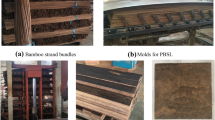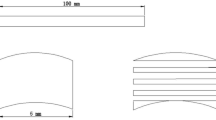Abstract
Splitting parallel to the culm fibers is common in full-culm bamboo structural members, even early in a structure’s lifespan. Currently, there is insufficient knowledge on the effect of splitting on member performance, which induces significant uncertainties in bamboo member engineering design. This is a potential threat to the safety of existing and future full-culm bamboo structures. This study investigates analytically the effect of a longitudinal crack on the stiffness of an originally intact bamboo culm in flexure. The study develops analytical expressions that describe stiffness loss in two flexure cases (a three-point bending and a four-point bending test) and verifies them with available experimental results and numerical simulations. Main cause of the stiffness loss is torsion-induced deflections, with secondary cause being shear deformations. Importantly, stiffness loss solely depends on two dimensionless parameters: the shape factor (radius-to-thickness ratio) and a factor that is a function of material properties and ratio of shear span length to culm diameter. Additionally, the study proves analytically that friction at the load application points mitigates torsion-induced deflections. This has important implications for bamboo structure design and testing standards, indicating that the manner in which loads are transferred on beams affects the apparent beam stiffness when a crack appears.










Similar content being viewed by others
References
Janssen, J.A.A.: Bamboo in building structures. PhD thesis, University of Eindhoven (1981)
Liese, W.: Research on bamboo. Wood Sci. Technol. 21(3), 189–209 (1987)
Amada, S., Ichikawa, Y., Munekata, T., Nagase, Y., Shimizu, H.: Fiber texture and mechanical graded structure of bamboo. Compos. B. Eng 28(1), 13–20 (1997). https://doi.org/10.1016/S1359-8368(96)00020-0. Use of composites multi-phased and functionally graded materials
Wu, W., Liu, Q., Zhu, Z., Shen, Y.: Managing bamboo for carbon sequestration, bamboo stem and bamboo shoots. Small-Scale For. 14(2), 233–243 (2015). https://doi.org/10.1007/s11842-014-9284-4
Huang, L., Krigsvoll, G., Johansen, F., Liu, Y., Zhang, X.: Carbon emission of global construction sector. Renew. Sustain. Energy Rev. 81, 1906–1916 (2018). https://doi.org/10.1016/j.rser.2017.06.001
ISO 22156:2021(E): Bamboo structures-Bamboo culms-Structural design. International Organization for Standardization (2021)
Wang, X., Ren, H., Zhang, B., Fei, B., Burgert, I.: Cell wall structure and formation of maturing fibres of moso bamboo (Phyllostachys pubescens) increase buckling resistance. J. R. Soc. Interface 9(70), 988–996 (2012). https://doi.org/10.1098/rsif.2011.0462
Dixon, P.G., Gibson, L.J.: The structure and mechanics of Moso bamboo material. J. R. Soc. Interface 11(99), 20140321 (2014). https://doi.org/10.1098/rsif.2014.0321
Wang, Y., Zhang, C., Chen, W.: An analytical model to predict material gradient and anisotropy in bamboo. Acta Mech. 228(8), 2819–2833 (2017). https://doi.org/10.1007/s00707-015-1514-0
Sharma, B., Harries, K.A., Ghavami, K.: Methods of determining transverse mechanical properties of full-culm bamboo. Constr Build Mater. 38, 627–637 (2013). https://doi.org/10.1016/j.conbuildmat.2012.07.116. 25th Anniversary session for ACI 228—Building on the past for the future of NDT of concrete
Richard, M.J., Gottron, J., Harries, K.A., Ghavami, K.: Experimental evaluation of longitudinal splitting of bamboo flexural components. Proc. Inst. Civ. Eng. Struct. Build. 170(4), 265–274 (2017). https://doi.org/10.1680/jstbu.16.00072
Lorenzo, R., Mimendi, L., Yang, D., Li, H., Mouka, T., Dimitrakopoulos, E.G.: Non-linear behaviour and failure mechanism of bamboo poles in bending. Constr. Build. Mater. 305, 124747 (2021). https://doi.org/10.1016/j.conbuildmat.2021.124747
Mouka, T., Dimitrakopoulos, E.G., Lorenzo, R.: Insight into the behaviour of bamboo culms subjected to bending. J. R. Soc. Interface (2021). https://doi.org/10.1098/rsif.2021.0913
Wegst, U.G.K.: Bamboo and wood in musical instruments. Annu. Rev. Mater. Res. 38(1), 323–349 (2008). https://doi.org/10.1146/annurev.matsci.38.060407.132459
Trujillo, D., Jangra, S., Gibson, J.M.: Flexural properties as a basis for bamboo strength grading. Proc. Inst. Civ. Eng. Struct. Build. 170(4), 284–294 (2017). https://doi.org/10.1680/jstbu.16.00084
Amada, S., Untao, S.: Fracture properties of bamboo. Compos. B Eng. 32(5), 451–459 (2001). https://doi.org/10.1016/S1359-8368(01)00022-1
Shao, Z.-P., Fang, C.-H., Tian, G.-L.: Mode I interlaminar fracture property of moso bamboo (Phyllostachys pubescens). Wood Sci. Technol. 43, 527–536 (2009). https://doi.org/10.1007/s00226-009-0265-2
Mitch, D., Harries, K.A., Sharma, B.: Characterization of splitting behavior of bamboo culms. J. Mater. Civ. Eng. 22(11), 1195–1199 (2010). https://doi.org/10.1061/(ASCE)MT.1943-5533.0000120
Mannan, S., Parameswaran, V., Basu, S.: Stiffness and toughness gradation of bamboo from a damage tolerance perspective. Int. J. Solids Struct. 143, 274–286 (2018). https://doi.org/10.1016/j.ijsolstr.2018.03.018
Eustáquio Moreira, L., Seixas, M.: Analysis of the bending behavior of bamboo culms with a full longitudinal crack. Eng. Struct. 251, 113501 (2022). https://doi.org/10.1016/j.engstruct.2021.113501
Timoshenko, S., Gere, J.M.: Theory of Elastic Stability, 2nd edn. McGraw-Hill, New York (1970)
Vlasov, V.Z.: Thin-Walled Elastic Beams, 2nd edn. Rev. and Augm. Translated from Russian ]by Y. Schectman]. Israel Program for Scientific Translations, Jerusalem (1961)
Cook, R.D., Young, W.C.: Advanced Mechanics of Materials, 2nd edn. Prentice-Hall Inc., Upper Saddle River (1999)
Liu, J., Cheng, S.: Analysis of orthotropic beams. US Dep. of Agriculture, Forest Products Laboratory (FPL 343) (1979)
Savoia, M., Tullini, N.: Beam theory for strongly orthotropic materials. Int. J. Solids Struct. 33(17), 2459–2484 (1996). https://doi.org/10.1016/0020-7683(95)00163-8
ISO 22157:2019(E): Bamboo structures—Determination of physical and mechanical properties of bamboo culms—Test methods. International Organization for Standardization (2019)
Nugroho, N., Bahtiar, E.T.: Structural grading of Gigantochloa apus bamboo based on its flexural properties. Constr. Build. Mater. 157, 1173–1189 (2017). https://doi.org/10.1016/j.conbuildmat.2017.09.170
Freund, J., Karakoç, A.: Shear and torsion correction factors for Timoshenko beam theory. Res. Eng. Struct. Mater. 2, 19–27 (2016). https://doi.org/10.17515/resm2015.19me0827
Gauss, C., Savastano, H., Harries, K.A.: Use of ISO 22157 mechanical test methods and the characterisation of Brazilian P. edulis bamboo. Constr. Build. Mater. 228, 116728 (2019). https://doi.org/10.1016/j.conbuildmat.2019.116728
Tarn, J.-Q., Chang, H.-H.: Torsion of cylindrically orthotropic elastic circular bars with radial inhomogeneity: some exact solutions and end effects. Int. J. Solids Struct. 45(1), 303–319 (2008). https://doi.org/10.1016/j.ijsolstr.2007.08.012
Sá Ribeiro, R.A., Sá Ribeiro, M.G., Miranda, I.P.A.: Bending strength and nondestructive evaluation of structural bamboo. Constr. Build. Mater. 146, 38–42 (2017). https://doi.org/10.1016/j.conbuildmat.2017.04.074
Bejo, L., Lang, E.M., Fodor, T.: Friction coefficients of wood-based structural composites. For. Prod. J. 50(3), 39–43 (2000)
Aira, J.-R., Arriaga, F., Íñiguez-González, G., Crespo, J.: Static and kinetic friction coefficients of Scots pine (Pinus sylvestris L.), parallel and perpendicular to grain direction. Mater. Constr. 64, 030 (2014). https://doi.org/10.3989/mc.2014.03913
Dassault Systémes: Simulia Abaqus V. 6.14-1, Vélizy-Villacoublay, France. https://www.3ds.com/products-services/simulia/products/abaqus/
Silva, E.C.N., Walters, M.C., Paulino, G.H.: Modeling bamboo as a functionally graded material: lessons for the analysis of affordable materials. J. Mater. Sci. 41, 6991–7004 (2006). https://doi.org/10.1007/s10853-006-0232-3
Acknowledgements
The authors thank Dr. Nischal Pradhan for providing the bamboo bending test photographs of Fig. 1. This work was supported by the University Grants Committee Research Grants Council of Hong Kong, under Grant Reference Number GRF 16213321.
Author information
Authors and Affiliations
Corresponding author
Additional information
Publisher's Note
Springer Nature remains neutral with regard to jurisdictional claims in published maps and institutional affiliations.
Appendices
A Schematic representation of the torsion problem
B Torsion in the three-point bending test
Normalized angle of twist \(\theta \) along the beam for the three-point and four-point bending test (\(P_\mathrm{{tot}}\) is the total load for each test and l is the total span length). The plot assumes the same span length for both tests (normalized shear span length \(n_{3p}=1.5n_{4p}=10\)), \(E_\parallel /G_\parallel =4.5\) and shape factor \(\phi \) = 5 (Eq. (22))
In the three-point bending test, and considering half of the beam because of symmetry, the load at end k (Fig. 12a) is P/2. The torque acting at the end k, because of the load is \(T_0=0.5P\cdot 2R=PR\) (Fig. 12a). Applying the boundary conditions, the resulting solution for angle of twist \(\theta _{3p}\) is (Fig. 13):
where \(0 \le {z} \le L_{3p}\) (Fig. 12a). Figure 13 shows that the angle of twist in the three-point bending test is larger than in the four-point bending test, assuming the same total load and total span length. The expressions for Saint-Venant torque \(T_{\mathrm{{s}},3p}\) and warping bimoment \(B_{\mathrm{{w}},3p}\) ensue by substituting Eq. (B1) into Eqs. (10) and (11):
where P is the load at the middle of the culm and \(L_{3p}\) is the shear span length of the three-point bending test, equal to half the total span. Note that, although the applied boundary conditions assume that the culm does not twist at the supports, Eqs. (B2) and (B3) are valid regardless, as long as the rest of the boundary conditions remain the same. Whether the culm twists at the supports or not, only affects the resulting angle of twist \(\theta \) (Eq. B1).
Subsequently, the deflection due to torsion for the three-point bending test (\(\delta _{t,3p}\)) occurs by substituting Eqs. (B2) and (B3), into Eq. (17), taking into account Eqs. (12) and (13), and calculating the integrals for \(z_m=L_{3p}\). \(\overline{T}_s\) and \(\overline{B}_w\) in Eq. (17) (Saint-Venant torque and warping bimoment, because of the virtual load) occur by setting P = 1 in Eqs. (B2), (B3). Thus,
where \(\phi \) is the dimensionless shape factor of the culm (Eq. 22) and n is the dimensionless shear span length (\(n=L_{3p}/\left( 2R\right) \)). Subsequently, combining Eq. (B4) with Eq. (1),
where \(\Theta \) is the shear-torsion deflection factor, as in Eq. (6). The deflection ratio of Eq. (B5) solely depends on the dimensionless terms \(\phi \) and \(\Theta \) (see also Eq. 25). Finally, the total deflection of the culm \(\delta _{\mathrm{{tot}},3p}\), during the three-point bending test, when there is a longitudinal crack at the side of the culm, occurs as a function of the deflection due to the bending moment \(\delta _{b,3p}\) from Eqs. (1), (5) and (B5):
where \(c_{i,3p}=8\).
Rights and permissions
Springer Nature or its licensor holds exclusive rights to this article under a publishing agreement with the author(s) or other rightsholder(s); author self-archiving of the accepted manuscript version of this article is solely governed by the terms of such publishing agreement and applicable law.
About this article
Cite this article
Mouka, T., Dimitrakopoulos, E.G. & Lorenzo, R. Effect of a longitudinal crack on the flexural performance of bamboo culms. Acta Mech 233, 3777–3793 (2022). https://doi.org/10.1007/s00707-022-03314-3
Received:
Revised:
Accepted:
Published:
Issue Date:
DOI: https://doi.org/10.1007/s00707-022-03314-3







